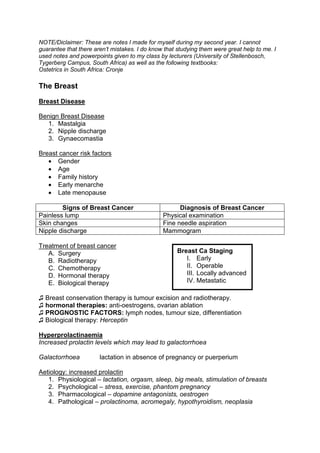No Title
- 1. NOTE/Diclaimer: These are notes I made for myself during my second year. I cannot guarantee that there arenŌĆÖt mistakes. I do know that studying them were great help to me. I used notes and powerpoints given to my class by lecturers (University of Stellenbosch, Tygerberg Campus, South Africa) as well as the following textbooks: Ostetrics in South Africa: Cronje The Breast Breast Disease Benign Breast Disease 1. Mastalgia 2. Nipple discharge 3. Gynaecomastia Breast cancer risk factors ŌĆó Gender ŌĆó Age ŌĆó Family history ŌĆó Early menarche ŌĆó Late menopause Signs of Breast Cancer Diagnosis of Breast Cancer Painless lump Physical examination Skin changes Fine needle aspiration Nipple discharge Mammogram Treatment of breast cancer A. Surgery B. Radiotherapy C. Chemotherapy D. Hormonal therapy E. Biological therapy ŌÖ½ Breast conservation therapy is tumour excision and radiotherapy. ŌÖ½ hormonal therapies: anti-oestrogens, ovarian ablation ŌÖ½ PROGNOSTIC FACTORS: lymph nodes, tumour size, differentiation ŌÖ½ Biological therapy: Herceptin Hyperprolactinaemia Increased prolactin levels which may lead to galactorrhoea Galactorrhoea lactation in absence of pregnancy or puerperium Aetiology: increased prolactin 1. Physiological ŌĆō lactation, orgasm, sleep, big meals, stimulation of breasts 2. Psychological ŌĆō stress, exercise, phantom pregnancy 3. Pharmacological ŌĆō dopamine antagonists, oestrogen 4. Pathological ŌĆō prolactinoma, acromegaly, hypothyroidism, neoplasia Breast Ca Staging I. Early II. Operable III. Locally advanced IV. Metastatic
- 2. Treatment A. Medical ŌĆō dopamine agonists B. Surgery C. Radiation

